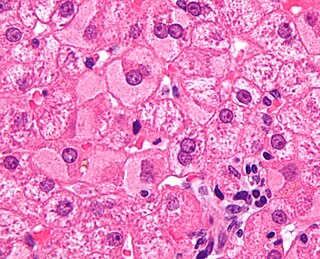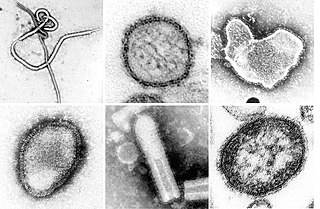An RNA virus is a virus that has RNA as its genetic material. This nucleic acid is usually single-stranded RNA (ssRNA) but may be double-stranded RNA (dsRNA). Notable human diseases caused by RNA viruses include Ebola virus disease, SARS, rabies, common cold, influenza, hepatitis C, hepatitis E, West Nile fever, polio and measles.

Hepatitis is inflammation of the liver tissue. Some people with hepatitis have no symptoms, whereas others develop yellow discoloration of the skin and whites of the eyes (jaundice), poor appetite, vomiting, tiredness, abdominal pain, and diarrhea. Hepatitis is acute if it resolves within six months, and chronic if it lasts longer than six months. Acute hepatitis can resolve on its own, progress to chronic hepatitis, or (rarely) result in acute liver failure. Chronic hepatitis may progress to scarring of the liver (cirrhosis), liver failure, and liver cancer.

Hepatitis C is an infectious disease caused by the hepatitis C virus (HCV) that primarily affects the liver. During the initial infection people often have mild or no symptoms. Occasionally a fever, dark urine, abdominal pain, and yellow tinged skin occurs. The virus persists in the liver in about 75% to 85% of those initially infected. Early on chronic infection typically has no symptoms. Over many years however, it often leads to liver disease and occasionally cirrhosis. In some cases, those with cirrhosis will develop serious complications such as liver failure, liver cancer, or dilated blood vessels in the esophagus and stomach.
Hepatitis D is a disease caused by the hepatitis delta virus (HDV), a small spherical enveloped virusoid. This is one of five known hepatitis viruses: A, B, C, D, and E. HDV is considered to be a subviral satellite because it can propagate only in the presence of the hepatitis B virus (HBV). Transmission of HDV can occur either via simultaneous infection with HBV (coinfection) or superimposed on chronic hepatitis B or hepatitis B carrier state (superinfection).

Hepatitis A is an infectious disease of the liver caused by Hepatovirus A (HAV). Many cases have few or no symptoms, especially in the young. The time between infection and symptoms, in those who develop them, is between two and six weeks. When symptoms occur, they typically last eight weeks and may include nausea, vomiting, diarrhea, jaundice, fever, and abdominal pain. Around 10–15% of people experience a recurrence of symptoms during the six months after the initial infection. Acute liver failure may rarely occur, with this being more common in the elderly.

Hepatitis E is inflammation of the liver caused by infection with the hepatitis E virus (HEV). Hepatitis E has mainly a fecal-oral transmission route that is similar to hepatitis A, but the viruses are unrelated. In retrospect, the earliest known epidemic of hepatitis E occurred in 1955 in New Delhi, but the virus was not isolated until 1983, by Russian scientists investigating an outbreak in Afghanistan. One of five known human hepatitis viruses: hepatitis A, B, C, D, and E, HEV is a positive-sense, single-stranded, nonenveloped, RNA icosahedral virus.

Viral hepatitis is liver inflammation due to a viral infection. It may present in acute form as a recent infection with relatively rapid onset, or in chronic form.

Hepacivirus C (HCV) is a small, enveloped, positive-sense single-stranded RNA virus of the family Flaviviridae. The Hepacivirus C is the cause of hepatitis C and some cancers such as liver cancer and lymphomas in humans.
A satellite is a subviral agent composed of nucleic acid that depends on the co-infection of a host cell with a helper virus for its replication.
A helper dependent virus also termed a gutless virus is a synthetic viral vector dependent on the assistance of a helper virus in order to replicate.

HBsAg is the surface antigen of the hepatitis B virus (HBV). It indicates current hepatitis B infection.

The hepatitis delta virus (HDV) ribozyme is a non-coding RNA found in the hepatitis delta virus that is necessary for viral replication and is the only known human virus that utilizes ribozyme activity to infect its host. The ribozyme acts to process the RNA transcripts to unit lengths in a self-cleavage reaction during replication of the hepatitis delta virus, which is thought to propagate by a double rolling circle mechanism. The ribozyme is active in vivo in the absence of any protein factors and was the fastest known naturally occurring self-cleaving RNA at the time of its discovery.

The mammalian CPEB3 ribozyme is a self cleaving non-coding RNA located in the second intron of the CPEB3 gene which belongs to a family of genes regulating messenger RNA polyadenylation. This ribozyme is highly conserved and found only in mammals. The CPEB3 ribozyme is structurally and biochemically related to the human hepatitis delta virus ribozyme. Other HDV-like ribozymes have been identified and confirmed to be active in vitro in a number of eukaryotes.

Coiled-coil domain-containing protein 85B is a protein that in humans is encoded by the CCDC85B gene.

Hepatitis B (HB) is an infectious disease caused by the hepatitis B virus (HBV) that affects the liver. It can cause both acute and chronic infections. Many people have no symptoms during the initial infection. Some develop a rapid onset of sickness with vomiting, yellowish skin, tiredness, dark urine and abdominal pain. Often these symptoms last a few weeks and rarely does the initial infection result in death. It may take 30 to 180 days for symptoms to begin. In those who get infected around the time of birth 90% develop chronic hepatitis B while less than 10% of those infected after the age of five do. Most of those with chronic disease have no symptoms; however, cirrhosis and liver cancer may eventually develop. Cirrhosis or liver cancer occur in about 25% of those with chronic disease.

Hepatitis B virus, abbreviated HBV, is a partially double-stranded DNA virus, a species of the genus Orthohepadnavirus and a member of the Hepadnaviridae family of viruses. This virus causes the disease hepatitis B.

Michael Houghton is a British scientist, who along with Qui-Lim Choo, George Kuo and Daniel W. Bradley, co-discovered Hepatitis C in 1989. He also co-discovered the Hepatitis D genome in 1986. The discovery of Hepatitis C led to the rapid development of diagnostic reagents to detect HCV in blood supplies which has reduced the risk of acquiring HCV through blood transfusion from one in three to about one in two million. It is estimated that antibody testing has prevented at least 40,000 new infections per year in the US alone and many more worldwide. Houghton is currently Canada Excellence Research Chair in Virology and Li Ka Shing Professor of Virology at the University of Alberta where he is also Director of the Li Ka Shing Applied Virology Institute.
Myrcludex B is an experimental drug for the treatment of hepatitis B and D. The first Phase IIa clinical trials with 40 patients concluded in 2014, finding that the drug was well tolerated and, as far as can be said with the limited data, effective against hepatitis B.

The phylum Negarnaviricota includes all negative-sense single-stranded RNA viruses except Hepatitis delta virus. It is divided into the subphyla Haploviricotina and Polyploviricotina. The name comes from the Latin nega ('negative') plus RNA and -viricota, the suffix for a virus phylum.












